Don't argue with the Markets, Stocks do not appear to be Anticipating Catastrophe
Stock-Markets / Stock Markets 2012 Apr 30, 2012 - 06:53 AM GMTBy: Brian_Bloom
 A fascinating chart crossed my desk yesterday – apparently originated by Doug Short and referred to by Mike Shedlock.
A fascinating chart crossed my desk yesterday – apparently originated by Doug Short and referred to by Mike Shedlock.
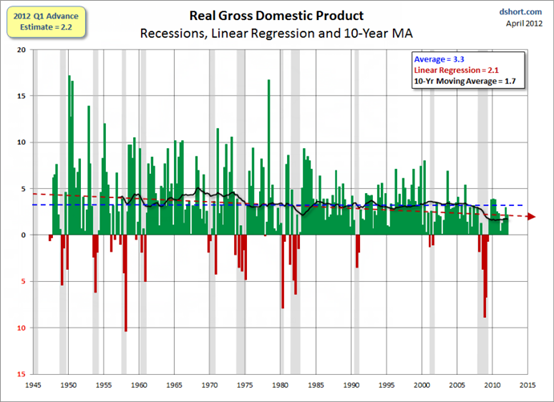
What interested me about this chart is that it is measuring a “rate of change” (yoy growth) of the US GDP, which is trending towards population growth rate plus around (say) 0.5% - 1% for improved productivity.
Effectively, what its saying is that we have basically picked the low hanging fruit and now we’re heading into either maintenance mode for the US economy or (at worst) negative growth. There will be no “startling” breakthroughs, unless there is a cyclical upturn flowing from the emergence of some new thought paradigm. But – given that the US is still the world’s largest economy – unless we moderate our propensity for profligacy, even if we do have a cyclical upturn, the limiting factor will be resource availability.
What the above chart certainly validates is that P/E ratios of greater than (say) 5 – 10 X cannot be tolerated in real terms.
The chart below – courtesy Decisionpoint.com – shows the actual P/E ratio of the S&P Index relative to the “fair value”, “overvalue” and “undervalue” as determined by historical averages.
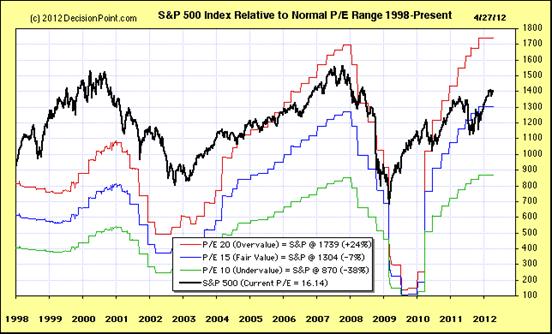
So, if (say) 5-10X seems fair “real” value given the slowing of the real growth rate, then either the current P/E ratio of 16.14X is assuming inflation (that will not impact on sales volumes) or the market has to pull back by at least 38%.
Let’s take a quick look at the “rule of 70”.
Very briefly , the rule of 70 states that if one divides the number 70 by the anticipated rate of return, then that will yield the number of years that it will take you to double your money. By contrast, if you divide the number 70 by the number of years it will take to double your money, then the result will be the compound rate of return.
It follows, in terms of the above chart, that 16.14X P/E implicitly assumes you will get your money back in earnings within 16.4 years (and still have your capital) – which implies a growth rate of 4.26% p.a.
If “real” growth is (say) 2.1% p.a. (the regression line) then the implied anticipated inflation rate – by the market – is 2.16% p.a.
Well, that’s around what it’s been for the past 100 years. If you had invested $100 a hundred years ago, and it had eroded at the rate of 2.16% p.a., then it would be worth $11.50 today. Nothing particularly remarkable. In that context, the market is currently reasonably priced and is not expecting an explosion of inflation. Arguably, that’s why “history” shows that 15X P/E is fair value – although in 1945 real growth would have been closer to 4.67% p.a. and inflation would have been closer to zero.
But now, another question is begged: If the market is pricing in 2.16% p.a. inflation then that is also the rate at which the gold price should be rising assuming a balance between supply and demand, and assuming that gold is not undervalued at today’s price. So let’s turn our attention to the relative level of the gold price.
The market is also giving off signals that the gold price has reached a point of decision. Will gold assume centre stage as the currency of last resort, or will it once again be viewed as an unusually valuable commodity? Let’s not make any assumptions and let’s not get involved in impassioned, esoteric arguments. Let’s just listen to what the markets are saying.
Here’s a weekly Relative Strength chart of Gold:Commodities – courtesy stockcharts.com
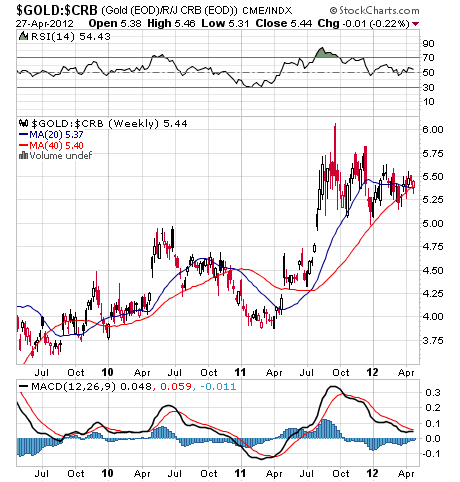
To be dispassionately objective, there is a clear breakaway gap at around 4.25 and then a runaway gap at about 4.75. The distance between the midpoints of the gaps is roughly 4.85 – 4.25 (0.6) and, therefore, the target move would have been to 4.85 + .6 = 5.45; which is where the ratio is now.
So the upside target has been reached and a new decision has to be taken: Will the triangle break down? In which case, the second gap (and maybe even the first) will be covered. Or is the triangle a continuation pattern? In which case, gold will start to outperform commodities quite dramatically. The oscillators seem to be pointing to a break up but the 20 week MA seems to want to penetrate the 40 week MA on the downside. Traders will likely be optimistic. But there are too many traders around. We need to look past what the traders may or may not be thinking. The fishing boat is a bit too crowded. Not everyone can catch his fill of fish. More likely the boat has a high risk of capsizing because too many people want to hang their lines off the same side of the boat.
To look past what the traders are thinking, we might have a look at the 3% X 3 box reversal chart: (also courtesy stockcharts.com)
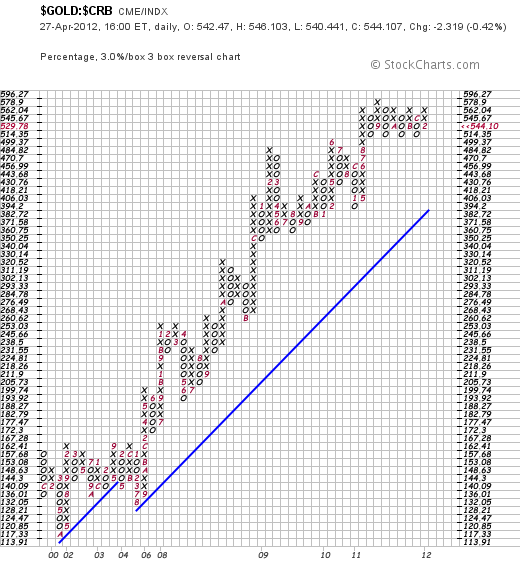
Note that there’s a lot of resistance at the 5.6 level (9 boxes across). That implies a 27% rise in gold relative to commodities if the break is on the upside – but it also implies a 27% to 36% fall if the break is on the downside. So the question is: What is the fundamental reason that gold will scream up? Well, it will scream up if the European crisis (or any other trigger) causes people to panic about the stability of the world’s financial system.
But, if investors were in fact worried about the stability of the world’s financial system (implying that the central banks will start to print money to kingdom come) then why is the US market only factoring in a roughly 2.2% p.a. inflation expectation?
Note from the first chart that the black line (actual P/E ratio) is at a lower level than the peaks in both 2008 and 2000. This is a not a sign that the market is expecting either rampant inflation or economic buoyancy and, therefore, the question of a possible 38% fall cannot be dismissed.
Of course, a 38% fall in equities is more than possible. But logic dictates that we should be seeing this possibility on the charts. So let’s look at what the charts are saying about equities. Below is 3% X 3 box reversal Point & Figure chart of the $SPX
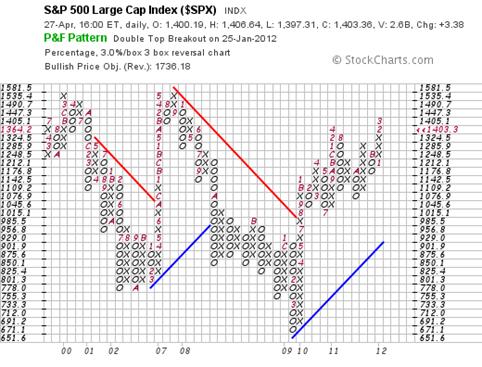
And here is the sensitive chart
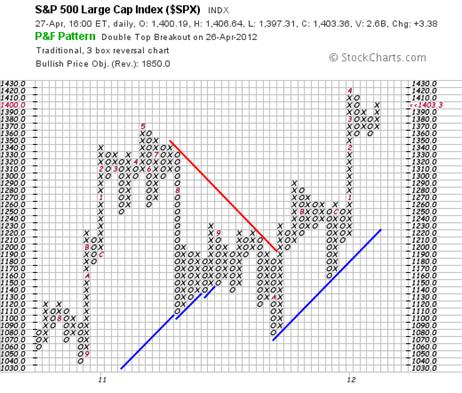
Both showing “buy” signals.
Could the Plunge Protection Team be goosing the market? Of course they could.
But have a look at the Nasdaq’s 3% X 3 box reversal chart
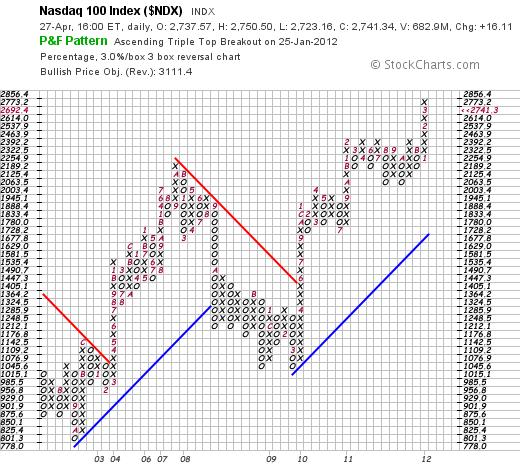
They are all giving of bullish signals. It doesn’t really matter why. In my mind it’s not a smart move to argue with the markets.
Overall Conclusion
With the $SPX P/E chart showing “fair” value, and with the Nasdaq charts showing buy signals on both the sensitive and desensitised charts, the equity markets do not appear to be anticipating catastrophe. Of course, we cannot sensibly make any investment decisions regarding the gold price until after the break (up or down). However, by logical extension to the observations regarding both buy signals and the absence of inflationary fear in the equity markets: Given that there is significant technical resistance to a further upside improvement of the gold price relative to commodities, the most logical direction of the “break” in the gold price chart relative to commodities will be on the downside.
Brian Bloom
Author, Beyond Neanderthal and The Last Finesse
In the global corridors of power, a group of faceless men is positioning to usurp control of one of the world’s primary energy resources. Climate change looms large. Can the world be finessed into embracing nuclear energy? Set in the beautiful but politically corrupt country of Myanmar, The Last Finesse, through its entertaining and easy-to-read storyline, examines the issues of climate change, nuclear energy, the rickety world economy and the general absence of ethical behaviour in today’s world. The Last Finesse is a “prequel” to Beyond Neanderthal, which takes a right-brain, visionary look at possible ways of addressing the same challenges. The Last Finesse takes a more “left brain” approach. It is being published in all e-book formats.
Copyright © 2012 Brian Bloom - All Rights Reserved
Disclaimer: The above is a matter of opinion provided for general information purposes only and is not intended as investment advice. Information and analysis above are derived from sources and utilising methods believed to be reliable, but we cannot accept responsibility for any losses you may incur as a result of this analysis. Individuals should consult with their personal financial advisors.
Brian Bloom Archive |
© 2005-2022 http://www.MarketOracle.co.uk - The Market Oracle is a FREE Daily Financial Markets Analysis & Forecasting online publication.



